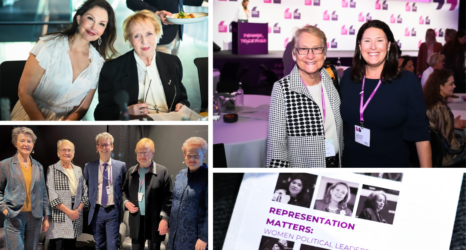On June 1, all eyes in the foodie community looked to London, where chefs and restauranteurs gathered for the World’s 50 Best Restaurants awards. Given annually (and sponsored by S. Pellegrino and Acqua Panna,) the awards are supposed to represent the “greatest places to eat in the world” and are decided by a panel of 972 experts, including chefs, food critics and restauranteurs.
You may have heard about the awards because of criticism that emerged following the ceremony: Chefs whose restaurants appeared on the list (and others) spoke out against the voting process, pointing to “lobbying and politics” as a source of corruption. But that’s not the only problem with the list: It’s also severely lacking in women.
Out of 50 internationally acclaimed establishments, only two restaurants had women chefs at the helm, and both were partnered with either their husband or father.
Strangely, instead of simply recognizing more women chefs alongside their male counterparts, there is a separate category sponsored by Veuve Clicquot called “Best Female Chef.” By designating a separate category for these highly acclaimed women chefs, 50 Best seems to be saying that although there are women worth mentioning, they can’t compete with the boys.
It might not be all bad, though, as some food awards show signs of improvement—particularly the James Beard Awards. The James Beard Foundation recognizes American chefs and industry professionals each year in what they call “the Oscars of the food world.” The award recipients are chosen by a confidential panel of judges composed of culinary professionals. Since 2009, only 22 percent of all James Beard Award winners have been women (with the exception of pastry chefs, a category dominated by women.) But if you examine the individual growth over the years, the numbers are slowly improving: while around 15 percent of the winners in 2009 were women, last year the number more than doubled to 38 percent women award-winners.
Some argue that the awards aren’t to blame—after all, women are severely underrepresented in the food industry generally. In 2014, for example, women held just 21 percent of head chef jobs, yet held 70 percent of jobs as servers, cafeteria workers or coffee shop workers. In the fine dining world of Michelin stars, the numbers are even worse: women make up only 6.3 percent of head chefs in America’s top restaurants. Perhaps even more startlingly, women hold 59 percent of jobs as “first-line supervisors of food preparation and serving workers,” demonstrating that while they have no lack of responsibility or culinary know-how, they aren’t ascending to head chef jobs in the way that men are.
Opinions vary on the cause of this severe gender disparity. Jean-Georges Vongerichten, a well-known French chef, cites “the ticking clock” as the reason many women executive chefs don’t rise any higher: “Many times when ladies become sous-chefs, as soon as they hit 27, 28, 30, they want to have a family. It changes everything.”
Chef Hélène Darroze, who won “The Veuve Clicquot World’s Best Female Chef Award 2015,” understands what he means, saying, “There’s one day in this job when you have to choose between being a wife and a mother and being a chef. The two things are very, very difficult to combine and most of the really talented young women in my kitchen stopped because they wanted to be a mom and a wife and they thought it was not compatible.” Unfortunately, this is a problem women in most fields face, as maternity leave and benefits for working mothers are almost non-existent in the United States.
Women chefs also cite sexist barriers preventing them from rising to the head chef position, calling the industry a “boys’ club” and relating encounters of sexual harassment in the industry. TIME magazine offered an example of that sexism in 2013 when it published the “Gods of Food” issue, intended to focus on the most influential chefs in the industry. Out of the 13 “gods” on the list, there were—surprise!—just 4 women, none of whom were chefs (they held positions such as coffee producer and author). Following the issue’s publication, multiple women chefs spoke out about what they thought needed to change. Some blamed the media’s representation of the industry, while others thought that the dynamic within the restaurant industry itself was sexist (men cook, while jobs like expediting “fall to the women.”)
It’s not for lack of women in the industry, though: Between 1997 and 2007, the number of restaurants owned by women increased by 50 percent. Esteemed culinary institutions are seeing rising numbers of women graduates, so it’s becoming harder to make the argument that there aren’t pools of young female talent for restaurants to draw from. More women are electing to return to work after having children, and potential legislative and judicial victories are underway to support working mothers in America. Perhaps it’s true that in the past years the Top 50 Restaurants awards have been unable to find women chefs because the industry is holding women back. But pretty soon, reviewers, award foundations and restaurants are going to run out of excuses.
Women have become increasingly vocal about supporting each other and drawing awareness to excellent female chefs, too—for example, Food & Wine published an all-women issue in January 2015. And new publications are emerging: Cherry Bombe, for one, is a biannual print magazine focusing on supporting women in food.
Kerry Diamond, the co-founder of the magazine, explains why she was inspired to create Cherry Bombe: “[I] noticed that interesting women were being left out of the food conversation for the most part. It’s an industry that glorifies men, although that’s changing.”
Diamond’s statement is spot-on. Although everything about the food industry currently—from the awards, to the magazine covers, to the makeup of the kitchens themselves—is overwhelmingly male, the industry is transforming. The Top 50 Restaurant judges had better start paying attention.
Get Ms. in your inbox! Click here to sign up for the Ms. newsletter.
Photo courtesy of Flickr user Japanexperterna.se licensed under Creative Commons 2.0
Emma Niles is a recent graduate of the University of California, Santa Cruz and an editorial intern at Ms. Follow Emma on Twitter @emmalorinda.





